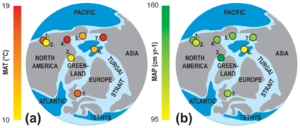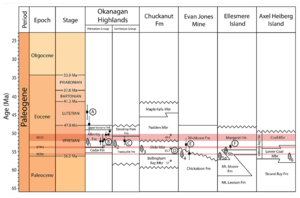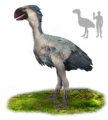Margaret Formation facts for kids
Quick facts for kids Margaret FormationStratigraphic range: Wasatchian 54.3–50.7Ma |
|
|---|---|
| Type | Formation |
| Unit of | Eureka Sound Group |
| Overlies | Mount Moore Formation |
| Thickness | 140 m (460 ft) |
| Lithology | |
| Primary | Sandstone |
| Other | Siltstone, coal, tuff |
| Location | |
| Coordinates | 78°42′N 81°54′W / 78.7°N 81.9°W |
| Approximate paleocoordinates | 76°06′N 30°42′W / 76.1°N 30.7°W |
| Region | Ellesmere Island, Northwest Territories, Nunavut |
| Country | |
| Extent | Sverdrup Basin |
The Margaret Formation is a special layer of rock found in northern Canada. It's part of a bigger group of rocks called the Eureka Sound Group. You can find it on Ellesmere Island in the Northwest Territories and Nunavut. This rock layer holds amazing fossils from a time long ago, called the Early Eocene period.
The Margaret Formation is made of different types of rocks. These include sandstones, siltstones, and layers of coal. It also has beds of volcanic ash. This rock layer is about 140 metres (460 ft) thick. Scientists have used special dating methods on the volcanic ash. They found the formation is about 52.6 to 53.7 million years old.
During the Early Eocene, the area where the Margaret Formation formed was much warmer. It was like a lush, wet forest, very different from the cold Arctic today. This warm environment was a great home for many animals. Scientists have found fossils of mammals, birds, reptiles, and fish here.
Contents
What is the Margaret Formation Made Of?
The Margaret Formation is mostly made of sandstones. These are rocks formed from sand. It also has sandy siltstones, which are like very fine sand. You can also find clay-rich sandstones and layers of coal. Coal forms from ancient plants. There are also beds of volcanic ash.
This rock layer is about 140 metres (460 ft) thick. It sits on top of another rock layer called the Mount Moore Formation.
Scientists believe the Margaret Formation formed in a wet, swampy area. It was likely a delta front or delta plain. This means it was near where a river met the sea. There were many river channels and coal swamps.
How Old is the Margaret Formation?
Scientists can tell how old rocks are using special methods. They found a layer of volcanic ash in the middle of the Margaret Formation. In 2017, they dated this ash to be about 53.7 million years old. Another study in 2010 dated ashes from the formation to about 52.6 million years old. These dates help us understand when these ancient environments existed.
What Was the Arctic Climate Like Long Ago?
During the Early Eocene, the climate in the northern parts of North America was very warm and wet. The average yearly temperature was around 20 °C (68 °F). There was a lot of rain, about 100 to 150 centimetres (39 to 59 in) each year. Winters were mild, with temperatures above 5 °C (41 °F). This warm weather allowed large temperate forests to grow.
In the Arctic, where the Margaret Formation is, the average yearly temperatures were between 7.6 to 12.9 °C (45.7 to 55.2 °F). The coldest months were still mild, from 1.3 to 4.2 °C (34.3 to 39.6 °F). The warmest months were much hotter, from 18.2 to 22.2 °C (64.8 to 72.0 °F). It rained a lot, especially in the summer.
The fossils and rocks show that this area was a lush, rainy forest. It was on a coastal delta plain. Scientists use different clues, like fossil plants and animal bones, to figure out the climate. They all point to a mild climate for the Arctic back then. Winters stayed above freezing, and summers were warm. This is very different from today's Arctic. Today, central Ellesmere Island has an average yearly temperature of −19 °C (−2 °F). The warmest month is only about 6 °C (43 °F), and the coldest is −38 °C (−36 °F) or colder.
Even with the mild climate, animals in the Eocene Arctic still had to deal with months of darkness in winter. Some mammals, like the hippo-like Coryphodon, lived there all year. A large, flightless bird called Gastornis also likely stayed all year. But another bird, Presbyornis, might have flown south for the winter.
What Fossils Are Found in the Margaret Formation?
The Margaret Formation is famous for its many fossils. These fossils tell us a lot about the animals that lived in the Arctic millions of years ago.
Mammals
Scientists have found many types of ancient mammals here.
- Primates
- Small, early primates like Paromomyidae indet.
- Meat-eating mammals
- Pachyaena sp.
- Miacis sp.
- cf. Vulpavus sp.
- Arcticanodon dawsonae
- Palaeonictis sp.
- Viverravus sp.
- Prolimnocyon sp.
- Other mammals
- Palaeosinopa nunavutensis
- Anacodon sp.
- Microparamys bayi (an early rodent)
- Paramys hunti (another early rodent)
- Strathcona major
- S. minor
- Prodiacodon sp.
- Ectypodus arctos
- Coryphodon pisuqti (a large, hippo-like mammal)
- Lambdotherium sp.
- Thuliadanta mayri
Birds
Two important types of birds have been found:
- Presbyornis cf. pervetus (a type of ancient duck or goose)
- Gastornis sp. (a very large, flightless bird)
Reptiles
Many reptiles lived in this warm, wet environment:
- Turtles
- Geochelone sp. (a large tortoise)
- Other types of turtles like Emydinae indet. and Trionychidae indet.
- Crocodiles
- Allognathosuchus sp. (an ancient crocodile)
- Lizards
- Various lizards, including Anguidae indet. and Varanidae indet.
- Snakes
- Ancient snakes like Erycidae indet.
Amphibians
- Piceoerpeton willwoodense (a type of salamander)
Fish
Fish fossils show that rivers and lakes were present:
- Esox sp. (an ancient pike)
- Amia fragosa (a type of bowfin)
- Amia cf. uintaensis
- ?Lepisosteus sp. (an ancient gar)
How Does Margaret Formation Compare to Other Rocks?
Scientists compare the Margaret Formation to other rock layers. This helps them understand how different areas were connected long ago. The Margaret Formation is similar to other Early Eocene rock layers. These include the Allenby Formation and Kamloops Group in British Columbia, Canada. It also matches up with the Chickaloon Formation in Alaska, USA.
Comparing these rock layers helps scientists learn more about ancient climates and how animals spread across continents.
Images for kids








